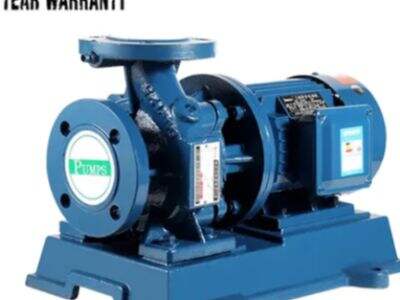Did you ever wonder how water or any other liquid reaches your home or school? For your information, one of the ways how it happens is with the help of a machine named the centrifugal pump. This text will explain how centrifugal pumps operate and why they are specifically crucial for the movement of water and all other liquid around us every day. Centrifugal pumps move liquid from place to place. As you spin a section called an impeller, which is a kind of wheel made up of bend blades, you work it out like a pro. The spin induces the liquidity to move, maintains the blade at every slope push the fluid forward. The impeller or assembly with run inside a structure called a case that contains the liquid and pumps it through a hose or pipe. As the impeller whips around in a good shape, it ejects the liquid noticeably powerfully, producing pressure. Consequently, the liquate flows to each place it must travel, like a drip at home or an important storage tank in a factory. Centrifugal pumps are used in many activities and areas because they can move a lot of fluid quickly and gently. For example, you can use it in agriculture to support your yield, drinking water facilities to clear the drinking water, or oil drilling to get the oil or gas around. Without these pumps, it would be difficult to move the tagged liquate, and our performance plans might falter. Assume you attached the tank and no liquid arrived out! That’s why centrifugal pumps are essential.
The Use of Centrifugal Pumps on Factories and Businesses
Centrifugal pumps are responsible for keeping all the things that needs to be in great condition, well conditioned by boosting their aeration as well capturing water from an original source and lending it off at pressure. These are used for a variety of purposes – such as moving water to prepare land for agriculture, transporting oil and gas over long distances or simply circulating cooling water in factories so that machines don't get too hot. Centrifugal pumps are used to transfer fluids, such as juices or sauces in the food and beverage industry. They are also largely used in the field of pharmacy where they help to transfer liquids and gases during the production of pharmaceuticals. A lot of these processes would be slower and far more complicated if the pumps were not part of our system.
Structural Components And Key Features Of Centrifugal Pumps
There are a few things that make centrifugal pumps the incldential pump to move liquids so well. The most critical of these functions is the large volume fluids Staff available pumpEquipment size made to efficiently move hefty top rated stream prices related with water or extra beverages. An absolute boon in industries where time is key. They are low tech compared to the plastic ones, so they are very easy to use and not hard at all. This is excellent because it requires very little training while still keeping things running smoothly and efficiently for workers.
Parts of a Centrifugal PumpCentrifugal pump has different main parts.Centrifgual pump impeller, casing,volute and bearing As discussed the impeller is responsible for turning which makes the liquid to go through movement. Casing is the stationary part which hold Casing impeller and guide flow of liquid from suction to outlet side. The volute help raise the pressure of liquid to levels where it can be delivered into an outlet. The bearings are finally because they support the impeller in order to easily rotate. Those parts are all work together and the things that make it be able to pump effectively.
The Pros and Cons of Centrifugal Pumps
While they can provide several advantages, centrifugal pumps also come with some downsides. The only real weakness of these is they struggle with thick liquids, e.g. syrup or molasses. The pumps may not be too suitable when it comes to these types of liquids. These pumps also are incapable of pumping solids, or sludges – substances composed of liquids and solids. Occasionally, cavitation occurs in those pumps. It occurs due to the fact that inside of a pump your pressure becomes too low, and you may have cavitation — this is when air bubbles are created in water which can collapse with force after its formation.
Centrifugal pumps are arguably the most commonly used pump in industrial applications because they have a lot to offer. They are cheap to run so that much work can be done for little money. They are also incredibly flexible in that they can be used across a wide range of applications and industries. This is why their use in multiple industries and contexts make them a favorite when it comes to liquid transfer.
How to maintain the Centrifugal pumps?
To ensure the proper functioning of centrifugal water pumps, they need to be maintained and serviced in time. This involves the inspection of bearings, seals and an impeller for any damage to them. Proper alignment including balance of the pump is also to be done. It is also important that the pump's flow rate and pressure are monitored in order to ensure it functions effectively. Priming: Priming is another step you can follow to start the pumprences of water within.system before using. This will ensure the pump is working properly right out of the box.



















































